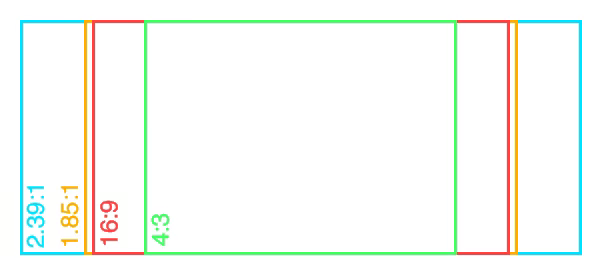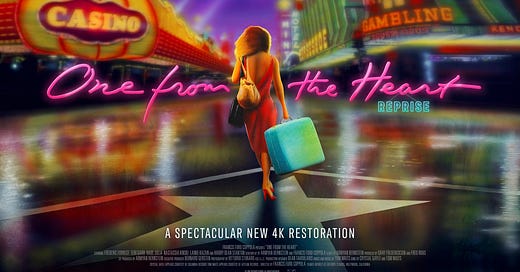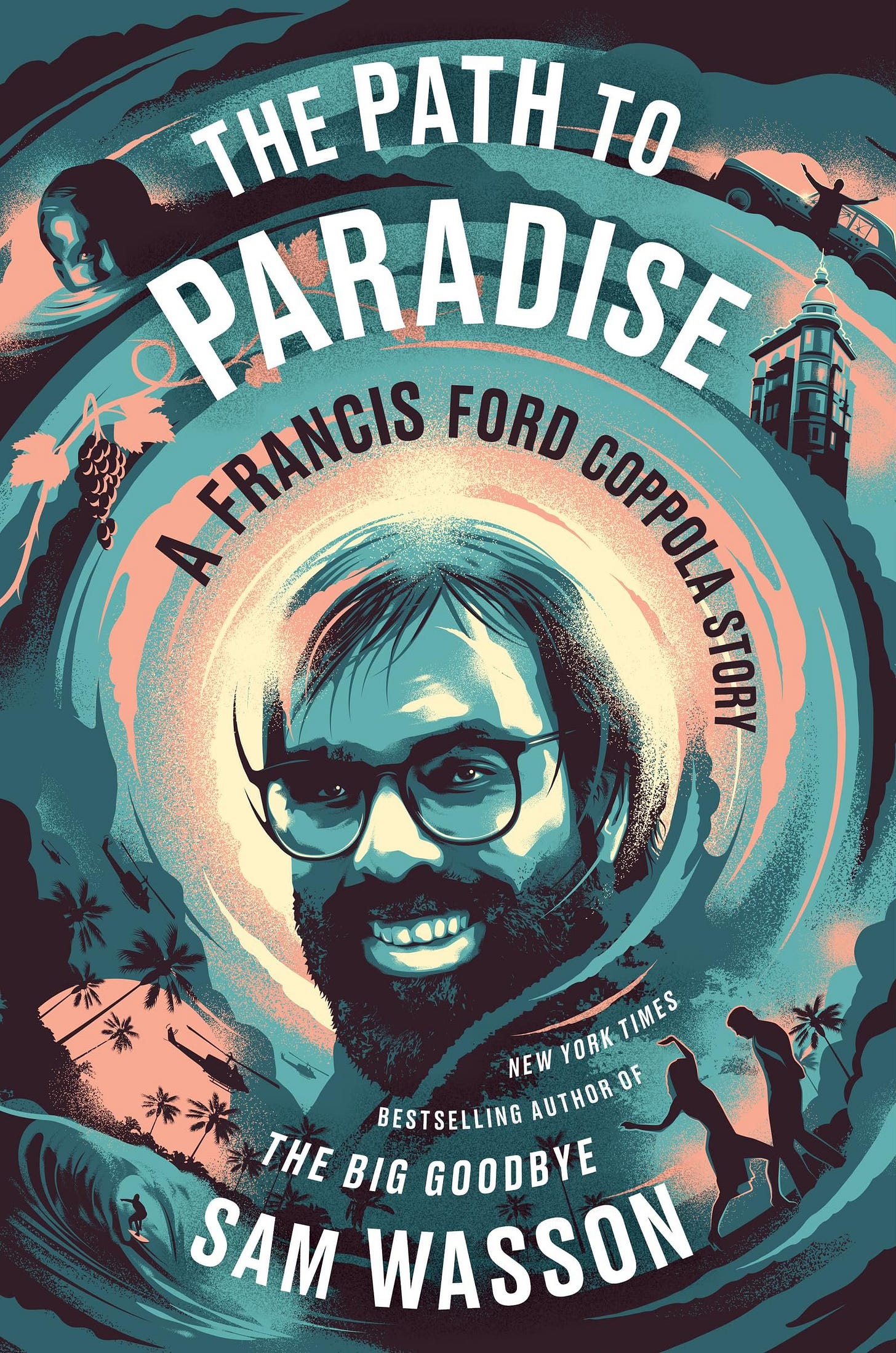One of the great things about living in Los Angeles is sometimes, a random trip to the movies can become the event of the year. I had recently listened to the audiobook, “The Path to Paradise,” by Sam Wasson, a history of Francis Ford Coppola’s Zoetrope Studios, from its emergence in the 70s, to Coppola buying a physical movie studio in the 80s to park Zoetrope, and losing that studio two years later to bankruptcy. It details the making of two movies during that period, “Apocalypse Now” and “One From the Heart.”
The bones of “Apocalypse” have been picked so clean they glow in the dark at this point. But you don’t hear about “One From the Heart” much these days. In fact, when I finished the book and tried to watch it online, I was saddened to discover it was available neither via streaming nor physical media. I had never seen it, and it seemed it would remain unseen by me, barring some very expensive or illegal activity on my part.
Lucky for me, the American Cinematheque recently hosted an event, a book signing by Wasson, featuring a screening of a re-cut version of the movie, re-titled “One From the Heart: Reprise,” to go with the musical theme of Coppola’s other recent re-cuts, “The Godfather: Coda,” and “The Cotton Club: Encore.” I bought tickets without any fuss, figuring there’d be a decent crowd, as when I’d recently attended a screening of “It’s a Mad, Mad, Mad, Mad World,” where the theater was about, mm, 75% full.
That… was an underestimation.
The screening was sold out when we arrived, and it was a who’s who of Hollywood, Rian Johnson, Karina Longworth, Luke Wilson, Danny Strong, Rebecca De Mornay, Army Bernstein, along with many other writers, directors, actors and assorted Tinseltown craftspeople. I hadn’t seen so many names at a movie screening since before the pandemic. I hadn’t realized there was such interest in this movie, but the attendees were VERY curious about how Coppola had recut his movie.
So how was it? Well, considering how much hate this movie gets, I was surprised I enjoyed it at all, let alone as much as I did. It's flawed in many (many) ways, but it’s a bigger swing than I think Coppola was given credit for. However, this is me saying that about a Director’s Cut, having never seen the original version, the only version that existed for forty years. And it got me musing about movies, and how, more and more these days, there is no longer a “definitive” version of anything... if, y’know, there ever was.
Movies have been getting recut probably since that prince walked around his garden and that train came barreling toward the audience. Being that movies in those days were on physical film, theater owners would often cut out “boring parts,” or things a local audience found offensive. Film prints by their nature would deteriorate and break, so while somebody in Bakersfield might see a complete movie, by the time that print hit Buffalo, bits and pieces and perhaps whole scenes could be clipped out. And studios would pull films themselves, re-edit them, and release new versions. When that happened in the pre-home video era, that usually meant the original versions were lost to history forever.
Speaking of which, the home market wasn’t kind to movies either. Movies on TV and VHS used to be so cropped and futzed with, seeing the movie correctly is a totally different experience. I’d wager you could make a study on Gen Xers like myself, who saw 90% of their media on a square TV screen rather than rectangular, and hypothesize that we developed a different visual aesthetic to the Boomers (and probably Gen Z and beyond) because of it. There’s moves I saw on VHS in the 80s and 90s dozens of times, and seeing the full picture on DVD or blu ray nowadays is like watching a different movie.
TV stations routinely edit movies for content and pacing, have done for decades. They’ll fuck up the format just so’s the audience won’t have to suffer the indignity of two slim black bars at the top and bottom of their screen. And it’s not just network TV that does this, streaming has continued the proud tradition, while pretending they’re honoring the original intent. They’ll routinely change the format, the sound, the picture, and for reasons I can’t even fathom. The other night, I watched Antoine Fuqua’s remake of “The Magnificent Seven” on AMC+, which filled the entirety of my 4k 16:9 TV (if you’re wondering, 16:9 is what they call “the ratio” of an HD TV screen), and while there were some shots that looked a touch fuzzy to me, Fuqua is one of those directors who plays with format and style constantly, so I figured it was on purpose. Get to the end, and as soon as the credits roll, they return the picture to its correct aspect ratio of 2.39:1. In short, the movie was supposed to have slim, I repeat, SLIM black bars at top and bottom, but they didn’t want those bars to make people think they weren’t getting the full picture, so they increased the size of the picture so those bars disappeared, along with either side of it as well. And “pushing in,” as we call it in the biz, tends to make the image less sharp. Hence the fuzziness.

(And don’t tell me the average person gives a shit about their whole screen being filled, I saw an ad for penile enhancement on Hulu, and it was in 2.39:1. Maybe even slimmer. The “Lawrence of Arabia” of penile enhancement ads.)
But that’s all studios and dustributors. I don’t know when it became normalized for the filmmakers themselves to start noodling with movies post-release. I’m sure it’s one of those things that happened plenty, and they just didn’t make a note of it for history. Again, there have been many times a studio yanked a movie from theaters and re-cut it, but in the studio system, directors weren’t usually involved. By the time a movie hit the screen, most directors had moved on to the next movie on the list, and the idea of revisiting an old one… I mean, why bother? If you didn’t like the old one, or even if you did, just remake it, like Hitchcock. Or make another movie kinda like it, but better. Like Ford, or Hawks, or lots of directors.
But, around the 70s, more filmmakers took an active role in the recutting of their films, because they were becoming more concerned with the art of the film. I became aware of it when George Lucas slapped a “Chapter 4” title on the front of "Star Wars." I'd seen the movie a few times, so even at the age of five or six, by the time “A New Hope” was placed atop the opening scroll, I noticed.
It wasn’t until the early 90s, when Ridley Scott released “Bladerunner - The Director’s Cut” to much fanfare and acclaim, that we, the general viewing audience, were made privy to the experience of a director recutting his film for release. Ridley Scott had gone twelve rounds with the studio over the original 1982 release of the movie, resulting in a theatrical cut that Scott more or less disowned. I don’t know who got the bright idea of giving the director his shot at “fixing” it, and thus, putting the movie back in theaters to recoup more of its lost budget, but it was a bit of marketing genius. Sure, the studio had to basically admit that they were wrong in the first place, but when it gets them millions of extry dollars, studios can get real self-effacing real quick. Watch how apologetic Warner Bros gets if “Batgirl” or “Coyote vs ACME” finally get released one day. “Oh, shit, we’ve been so wrong all these years,” they’ll say, a tear in their eye and and wads of cash in their fists. And of course, the big plus for a Director's Cut is we, the audience, get to see the quote-unquote “real” version of the movie, as God intended.
“Bladerunner” is more popular than ever, certainly more popular than when it was released in 1982, and whenever the movie is ported over to a new format, they include around five different versions for audiences to compare and contrast, including the Theatrical Cut, which was the first, the Director’s Cut, the International Cut (international versions are an entirely more confusing beast, but trust me when I say they can vary widely from the original version), an early work print, and the so-called Final Cut, which Scott went in and recut AGAIN based on the popularity of the Director’s Cut. It wasn’t like the public was screaming for the “real REAL” Director’s Cut, my understanding is Scott just wanted to make some tweaks. I’ve seen the Final Cut, and I have no idea what makes it better, worse, or any different than the Director’s Cut. This might honestly be for the best, you don’t necessarily want your audience to see the changes. Which is what I’ve been thinking about a lot of late.
Experience has shown me most people don’t necessarily want to fuck around and watch twelve different versions of their favorite thing. A director getting the chance to right a wrong and recut their movie away from studio interference is one thing, especially in the case of “Bladerunner,” where Scott made some substantial narrative changes, most of them certainly for the better.
But some filmmakers just cannot keep their gotdamn hands offa their movies, noodling endlessly, doing little nips and tucks they think “improve” the shit. George Lucas, the junior partner in the original American Zoetrope, famously revised “Star Wars” constantly over the years, even getting in one last fucking twist of the knife before he handed the movie over to Disney, by adding Greedo yelling the horrifically awkward phrase “Maclunkey!” before Han Solo shoots him. That infamous “Han Shot First” scene has been maligned for years, and Lucas really doesn’t seem to get why people liked the original version, where, as the name implies, Han shot Greedo before the bounty hunter had a chance to pull the trigger at point blank range. Guess Lucas figured if he recut it enough times, he’d finally hit the magic, and people would go, “ohhhh, I get it now. Greedo is a bad guy and Han Solo is a good guy! Oh shit, I’ve been so wrong all these years!” (This is, by the way, the same guy who claims he doesn’t understand why everybody loves Boba Fett. Sure. Like he didn’t model him after Clint Eastwood’s “Man With No Name,” the coolest anti-hero ever. Think I’m kidding? Listen to when Boba Fett walks. You can hear the sound of spurs jingling.)
Lucas and Coppola are hardly the only directors who do this. Every time Michael Mann re-releases his movies in a new format, be it DVD, blu-ray or whatever, he goes in and re-edits, whether it needs it or not. “Heat” has so many different unheralded versions it’ll make your head spin. Most of the time, maybe you don’t really notice. But with “Heat,” there was one cut in particular that bothered me. In the theatrical cut in one scene, Al Pacino is screaming at a flummoxed Hank Azaria. Enjoying the effect he’s having, Pacino smiles gleefully at him and says, “Ferocious, aren’t I?!”
I loved that line. It was one of the many, many lines from “Heat” I quoted over the years.
And on one of the DVD releases, Mann took it out.
Maybe it makes the movie better for people who’ve seen it since, and I can’t tell. I don’t know. But there’s something about its removal that really bothers me. Something about it feels sneaky. Like Lucas trying to claim, oh no, Greedo ALWAYS shot first, you just didn’t get it. Like, the way a certain politician will be caught saying or doing something on tape, from multiple angles, and when asked why he did it, will say, “no, I never did that.” Dude, we all saw it. And I’m sorry, I LIKED it when Pacino said, “Ferocious, aren’t I?!” I would honestly prefer that every cut from now on be labeled “Heat; the Non-Ferocious Fuckoff Cut,” so I can properly put it in context.
I’m sure some of you know what I’m talking about. One of your favorite bits in a movie, you KNOW you saw it, you loved it when you did, but then to never see it again when you watch that movie, it can make you crazy. Memory is unkind to all of us, it’s bad enough when we remember things differently in a movie and it wasn’t actually changed, so the filmmakers fucking around and tricking us is no help. The recent “Spider-Man: Acrost the Spider-Verse” had at least three different iterations. The filmmakers originally claimed it was intentional, to play on the idea of the multiverse, so if you saw the movie in a different theater, you had a different experience. That’s cute and all, but the movie hits streaming and blu-ray, and it’s locked into a single version, and again, that one bit you liked? Might be gone forever. Hope you remember it right.
Look, I’m not necessarily advocating that there should only be a single official canon version of a film, the end, no exceptions. It’s fun to have different versions sometimes. But like, those changes should move the needle a little, right? As I mentioned, a few years back, Coppola issued a recut version of “The Godfather Part III”, which itself was a cleaned-up version of the rough cut, available for years in the bonus footage on the DVD. Did it make the movie better? I mean, debatably. I think that movie needed more than a recut to make it work (and no, I’m not talking about Sophia Coppola, who gets all the shit for “ruining” that movie, she was barely in it). Shifting some scenes around, while stylistically interesting, didn’t produce the “ahhhh!” moment i think Coppola might have been hoping for. It’s interesting that it exists, but it wasn’t like “Bladerunner,” which gave the audience a new and arguably deeper way to look at the material. Some may disagree, but it added complications to the theme of the movie. Which, to me, justifies the recut. If you’re only changing the window dressing, or adding five seconds of guts flying, are we really adding to the collective narrative? Are we really moving the needle? I mean, I’ve got some opinions on the “Justice League” Synder Cut, but even I think the latter version is better. That was a needle-shifter, for good or ill. The original “Justice League” and the Synder Cut are two completely different movies now.
(But speaking of Zach Synder, don’t get me started on movies like “Rebel Moon Pt. I,” where they notify us in advance, yes, the movie will be on Netflix in November, but the much longer Director’s Cut will be available down the line. Congrats, you just made me not give a shit about the version you’re releasing first.)
I guess I’d prefer we clutter the waters by allowing the multiple versions to at least be available, but then again, I’d probably be the only one buying the “Heat: Totally Ferocious Version.” This is a mass media, and even now, with incredibly niche content for all, there’s no sense trying to make a version of every movie for everyone. But then again, “One From the Heart: Reprise” was sold out, so what do I know?
So I guess I’m back where I started, with no solutions and no new ideas for the future. So I’m now ready to run a movie studio. Ahhhh, shit, just kidding fam! But that was good.
©2024









Really really good piece here. I never heard Boba Fett's spurs, but The Mandalorian makes the same basic reference. "I can bring you in warm, or I can bring you in cold." And Lucas has said that westerns inspired Star Wars, so I’m sure you’re right. I also liked The Snyder Cut FAR more than the original. Really enjoyed reading this. Even learned a thing: I didn’t realize exhibitors actually cut out parts they didn’t like. I’ve always heard the projectionist cut the final cut, though. Nice work